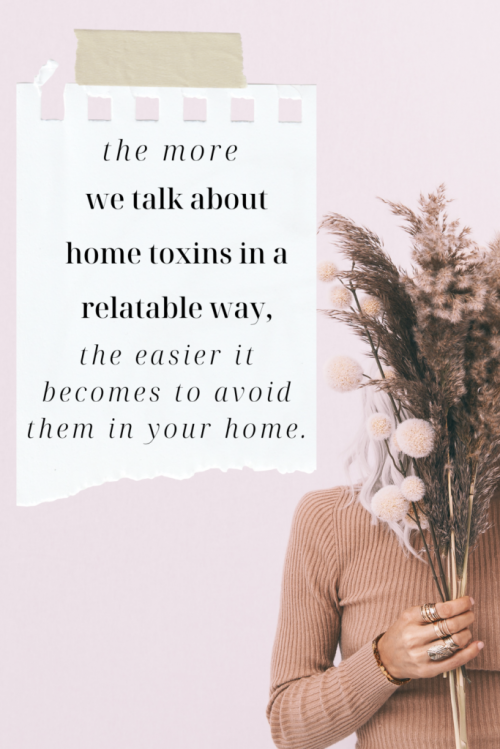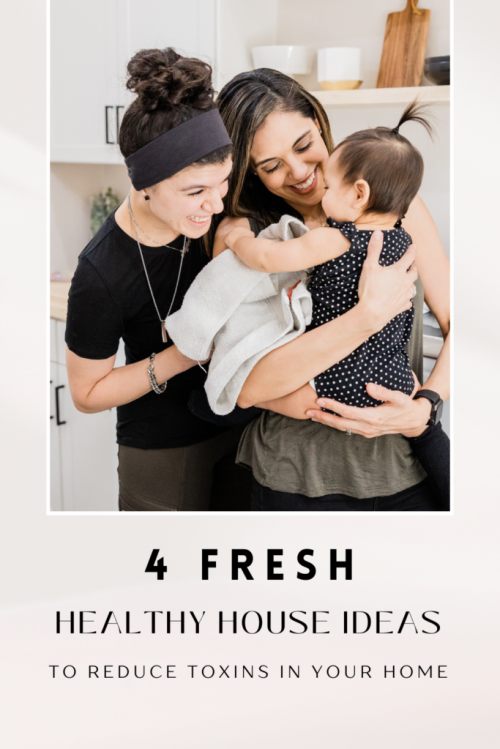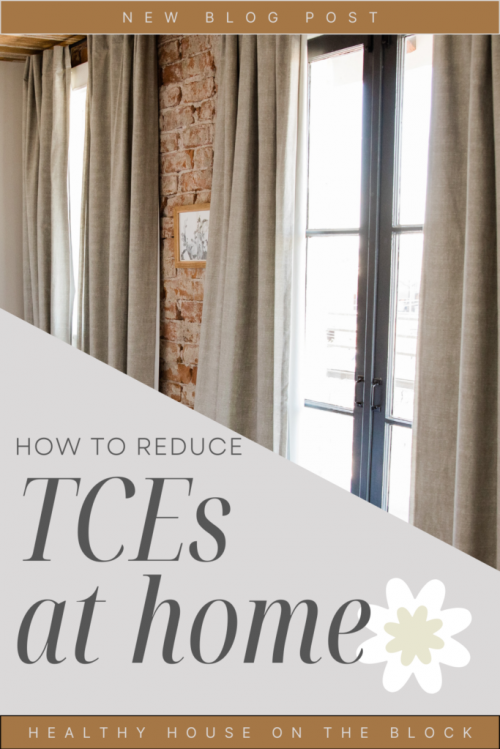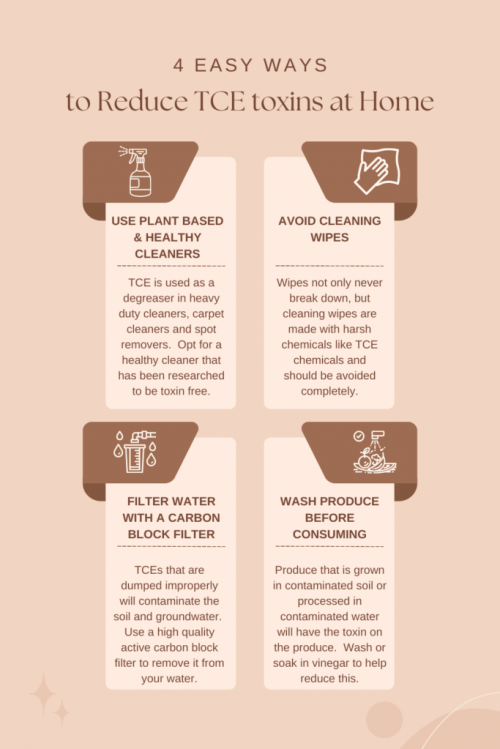
I think one of the most beneficial things that can aid you in REALLY cutting chemicals out of your home is by understanding more ABOUT the toxins and chemicals we’re trying to avoid. There are so many human-made chemical toxins in our world that I’m really just scratching the surface with many of these toxin deep-dives that I do. This week I felt like it was high-time we talked about TCE chemicals, or trichloroethylene. It’s been discussed more and more and it’s still in some of the products we bring into our homes in the US.
Once you have a good understanding of WHY a particular chemical is toxic and what the health risks are, your brain just naturally remembers that you DON’T want it in your house. It’s the concept behind teaching kids the rules of phonics and grammar rules instead of having them memorize how to spell each individual word anymore. The more we talk about these toxins in a way that is relatable to you and your home, the easier it becomes to avoid them or swap them out in your home.
There have been toxins such as trichloroethylene that even I have learned new things about. And when I do understand how the toxin enters our home, and see how I can change that, it becomes a toxin that I really don’t have to worry about in the future.
If you missed any of my toxin deep dives in the past, here’s a quick list:

WHAT ARE TCEs?
TCEs or Trichloroethylene is a human made chemical used in a variety of products. It evaporates at room temperature into the air, which puts it into the VOC category of toxins. The risk for TCEs was once thought to be more of an occupational hazard for some, but what we’re finding now is that there are risks for TCE chemicals in our homes in the air and in the water.
Trichloroethylene is oftentimes used as an industrial degreaser, and when improperly disposed ends up in ground water and soil, contaminating our drinking water, air and soil around our homes. The chemical can also evaporate from polluted soil and enter your home through cracks or around pipes and drains.
This chemical is widely known for being in dry cleaning solvents, and so wearing clothing that has been freshly dry cleaned attributes for a large amount of exposure. But it has also been found in a number of products we bring into our homes on a regular basis, which is where we can control a lot of the exposure.

WHERE ARE TCE CHEMICALS FOUND IN YOUR HOME?
Paint Remover: Often paint thinners and paint removers are extremely toxic due to the nature of the task at hand. These solvents need to break down oil based and latex paints that are meant to withstand soap and water clean up. Oftentimes we’re using our hands with this product, which can mean it can be absorbed through the skin as well.
Carpet Cleaners & Spot Removers: Heavy duty cleaners need to cut through grease quite often, and we all know that any good spot remover or carpet cleaner needs to do just that. Unfortunately TCEs are one of the ways that this can be accomplished. When the product sits on carpet or clothing, it can create a situation where we’re exposed via inhalation as well as skin absorption.
Cleaning Wipes: Just to go on the record — generally cleaning wipes are a BIG no-no. Wipes are formulated in a way that prevents them from breakdown …. EVER. You can try it for yourself and let one sit in water. A paper towel or tissue would eventually disintegrate. But a wipe would not, meaning they end up in landfills or worse in our plumbing drains and sewers for a lifetime. Cleaning wipes are often very harsh and while convenient, shouldn’t be used.
Ground water: Because TCEs have been used extensively in some occupations (namely by the US Military to degrease equipment), contaminated soil and groundwater is a huge issue near current and former military bases. The chemical can also evaporate from polluted soil and enter your home through cracks or around pipes and drains.
Foods Washed or Processed with Contaminated Water: Produce washed and processed with contaminated groundwater will also contain trichloroethylene chemicals on the food.

HEALTH RISKS OF TCE EXPOSURE AT HOME
Prolonged exposure or repeated exposure to trichloroethylene has been linked to different types of cancers. Specifically, the increased risk for kidney cancer, liver cancer and non-hodgkin lymphoma. (SOURCE)
There has also been research linking Parkinsons’ Disease (a disease that pulls at my heart) to trichloroethylene. Exposure from both inhalation and skin absorption have increased the risk of developing Parkinson’s years and even decades later. (SOURCE)
Trichloroethylene has also been linked to other common neurodegenerative disorders such as ALS and Alzheimers. (SOURCE)
TCEs have also been linked to issues with the reproductive system, likely because it does have some level of hormone disruption properties (as do almost all VOCs). As trichloroethylene chemicals alter the endocrine system’s natural production of hormones, it in turn will negatively affect systems of the body that rely on our healthy hormone production, such as the reproductive system.

HOW TO AVOID TCE CHEMICALS IN YOUR HOME
The US unfortunately continues to allow TCE chemicals in products that we use, however if you happen to find a product created in Europe, you may have better luck The EU has banned trichloroethylene in almost all products due to its adverse health effects and the way it was contaminating their soil, water and air around the country.
One of the best and easiest ways to avoid TCE toxins in your home is to simply avoid bringing them in. You can do this by finding plant based cleaners that don’t contain any chemical toxins. This post I did on using healthy product databases can help you find home products that are safe for your house.
Basically, you can audit anything that’s coming into your home from cleaning products to makeup and even your furniture and food. YOU get to the one to decide on what is allowed, and what doesn’t pass your threshold. It’s such an empowering feeling to finally embrace this. And let me warn you, you will have family and friends who think you’re being ridiculous, but just know that you’re doing your home and body a favor by being THAT picky about what enters your space.

HEALTHY HOUSE SWAPS TO CUT OUT TCE CHEMICALS
AspenClean: AspenClean is an EWG Verified company and ECO Certified. Their products are SO high quality, and after using them for the past year and half I am in love. We use the concentrated cleaner in just about EVERY application from a spot treater to a kitchen cleaner and bathroom cleaner. It is extremely concentrated, so you’re only using a small amount in each cleaning bottle, making it an EXTREMELY affordable option for a toxin free cleaner.
One of their concentrated cleaners makes 35 spray bottles of cleaner (which means it’s roughly $.68 per bottle).
I recommend their concentrated cleaner as a carpet cleaner and spot treater (in fact I just used it in these two applications yesterday thanks to my two year old). I also feel completely at peace knowing my kids will be around this cleaner. It’s an excellent alternative to SO many cleaning products.
Activated Carbon Filter: I think it’s important to have ALL of your drinking water filtered. And an activated carbon filter will get you the most contaminants filtered out for the most affordable option. Activated carbon will filter out trichloroethylene because the filter uses adsorption to trap the chemicals and prevent them from passing through the filter. There are several different ways you can use an activated carbon filter in your own home:
- Pitcher with Activated Carbon Filter: WaterDrop Eco Pitcher
- Point of Use Reverse Osmosis with Activated Carbon Filter: WaterDrop G2P600
- Whole House Activated Carbon Filter: Aquasana
Toxin Free Paint Remover: This post I did over the summer was all about refinishing furniture in a healthy way, and it did in fact link you up to three of my favorite low toxin paint removers. Finding a soy based or zero-voc formula will help you reduce introducing TCE toxins into your home.
- Blue Bear Safenol (soy based and 100% biodegradable)
- Peel Away (zero-voc and 100% biodegradable)
- Dumond Smart Strip (alcohol based and 100% biodegradable)
Fruit & Veggie Soak: Every week when I get home from grocery shopping, I soak my produce (pretty much all of it) in a vinegar and cold water solution in my sink. This can help cut down on not only surface dirt and residue (which can contain toxins from the soil and transport), but also reduces bacteria as well.
To wash your fruits and veggies this way, start with a clean sink (I scrub mine down before doing this) and then use a solution of three parts water to one part vinegar. LEt it soak for 15 – 20 minutes and then rinse your produce with cold water.

Knowing just how to change your habits to avoid certain types of toxins and knowing just how to keep certain products and materials out of your home can make ALL the difference in creating a truly healthy space. Remember that a home with few toxins and a plethora of fresh air is a home that supports health and wellness rather than burdening your body.
What toxins have you been hearing about that you want to understand better?


